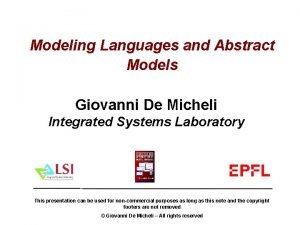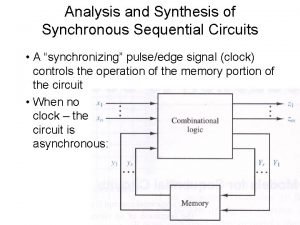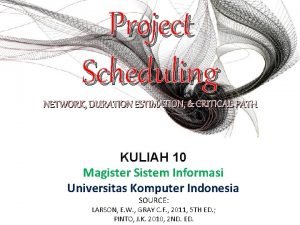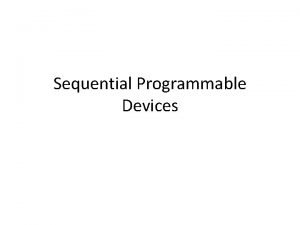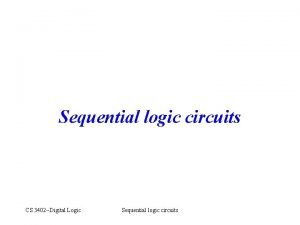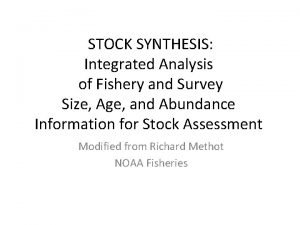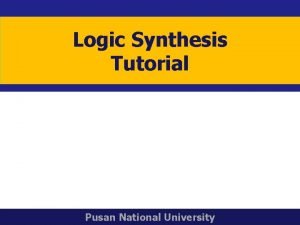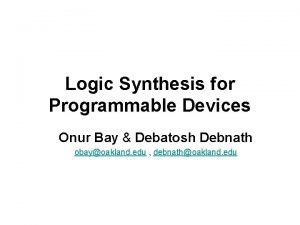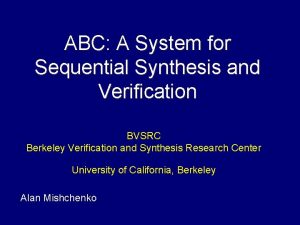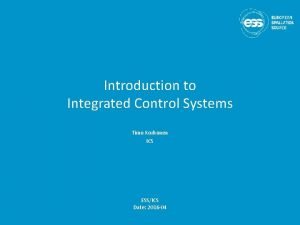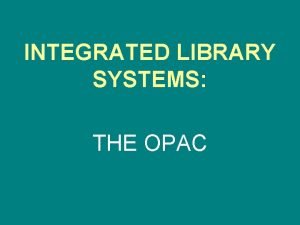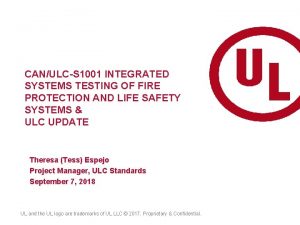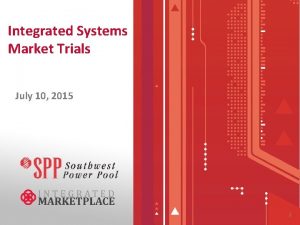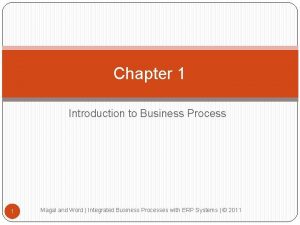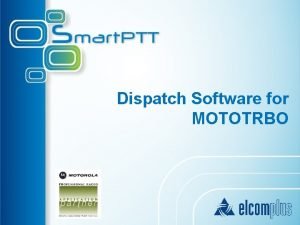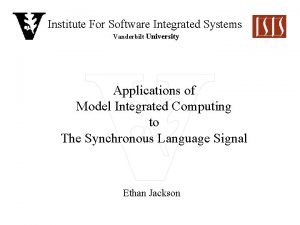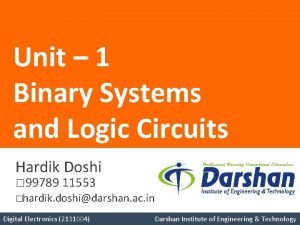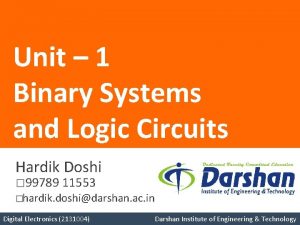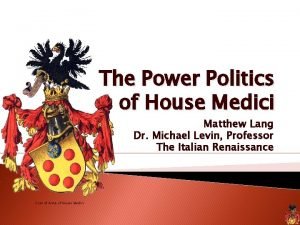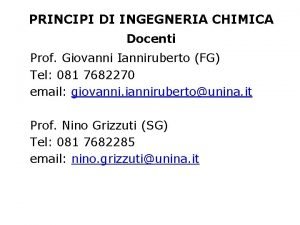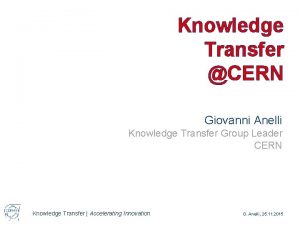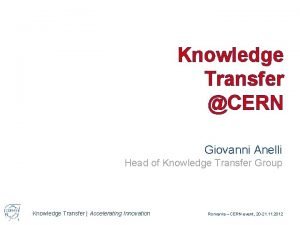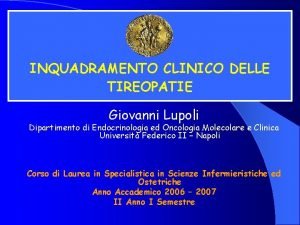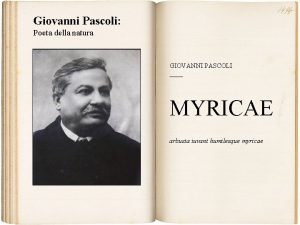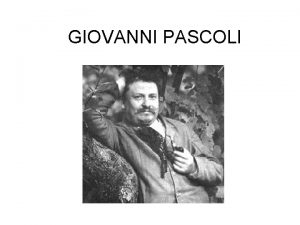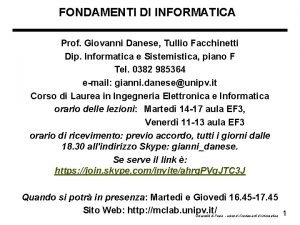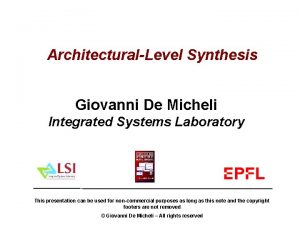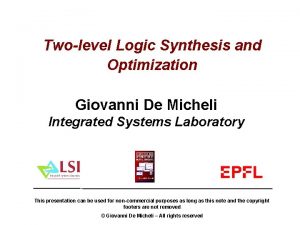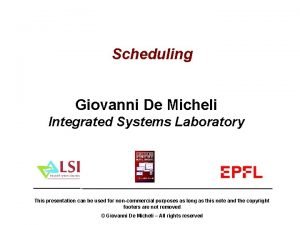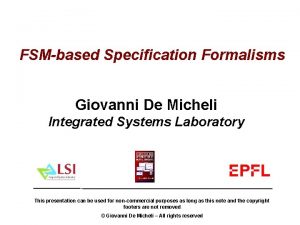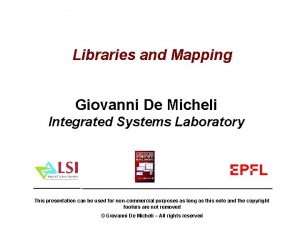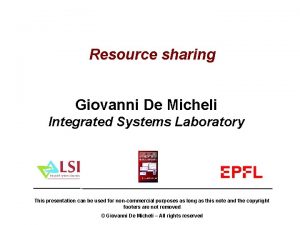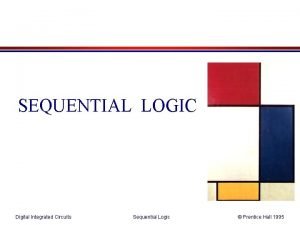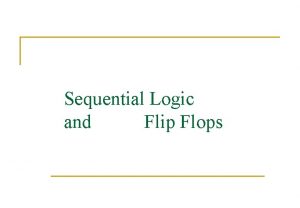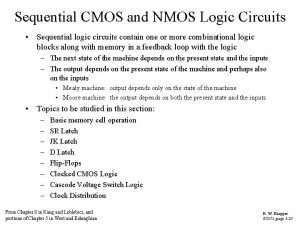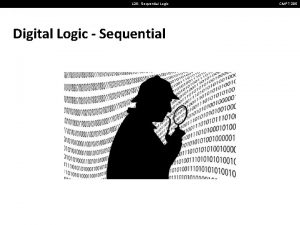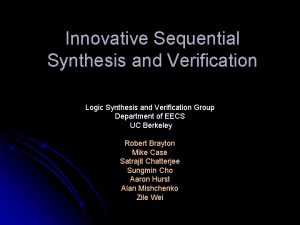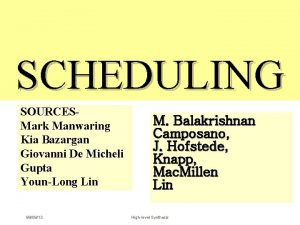Sequential Logic Synthesis Giovanni De Micheli Integrated Systems











































































- Slides: 75

Sequential Logic Synthesis Giovanni De Micheli Integrated Systems Laboratory This presentation can be used for non-commercial purposes as long as this note and the copyright footers are not removed © Giovanni De Micheli – All rights reserved

Module 1 u Objective s Motivation and assumptions for sequential synthesis s Finite-state machine design and optimization (c) Giovanni De Micheli 2

Synchronous logic circuits u Interconnection of s Combinational logic gates s Synchronous delay elements t Edge-triggered, master/slave u Assumptions s No direct combinational feedback s Single-phase clocking u Extensions to s Multiple-phase clocking s Gated latches (c) Giovanni De Micheli 3

Modeling synchronous circuits u Circuit are modeled in hardware languages s Circuit model may be directly related to FSM model t s Description by: switch-case Circuit model may be structural t Explicit definition of registers u Sequential circuit models can be generated from high-level models s Control generation in high-level synthesis (c) Giovanni De Micheli 4

Modeling synchronous circuits u State-based model: s Model circuits as finite-state machines (FSMs) s Represent by state tables/diagrams s Apply exact/heuristic algorithms for: t t State minimization State encoding u Structural model s Represent circuit by synchronous logic network s Apply t t Retiming Logic transformations (c) Giovanni De Micheli 5

State-based optimization (c) Giovanni De Micheli 6

Modeling synchronous circuits u Advantages and disadvantages of models u State-based model s Explicit notion of state s Implicit notion of area and delay u Structural model s Implicit notion of state s Explicit notion of area and delay u Transition from a model to another is possible s State encoding s State extraction (c) Giovanni De Micheli 7

Sequential logic optimization u Typical flow s Optimize FSM state model first t s Encode states and obtain a structural model t t s Reduce complexity of the model E. g. , apply state minimization Correlates to area reduction Apply retiming and transformations Achieve performance enhancement Use state extraction for verification purposes (c) Giovanni De Micheli 8

Formal finite-state machine model u A set of primary input patterns X u A set of primary output patterns Y u A set of states S u A state transition function: δ: X × S → S u An output function: s λ: X × S → Y for Mealy models s λ: S → Y for Moore models (c) Giovanni De Micheli 9

State minimization u Classic problem s Exact and heuristic algorithms are available s Objective is to reduce the number of states and hence the area u Completely-specified finite-state machines s s No don’t care conditions Polynomial-time solutions u Incompletely-specified finite-state machines s Unspecified transitions and/or outputs t s Usual case in synthesis Intractable problem: t Requires binate covering (c) Giovanni De Micheli 10

State minimization for completely-specified FSMs u Equivalent states: s Given any input sequence, the corresponding output sequence match u Theorem: s Two states are equivalent if and only if: t They lead to identical outputs and their next-states are equivalent u Equivalence is transitive s Partition states into equivalence classes s Minimum finite-state machine is unique (c) Giovanni De Micheli 11

State minimization for completely-specified FSMs u Stepwise partition refinement: s Initially: t s Iteratively: t s All states in the same partition block Refine partition blocks At convergence: t Partition blocks identify equivalent states u Refinement can be done in two directions s Transitions from states in block to other states t s Classic method. Quadratic complexity Transitions into states of block under consideration t Inverted tables. Hopcroft’s algorithm. (c) Giovanni De Micheli 12

Example of refinement u Initial partition: s Π 1 : States belong to the same block when outputs are the same for any input u Iteration: s Πk+1 : States belong to the same block if they were previously in the same block and their next states are in the same block of Πk for any input u Convergence: Π = Π k+1 k (c) Giovanni De Micheli s 13

Example (c) Giovanni De Micheli 14

Example (c) Giovanni De Micheli 15

Example uΠ 1 = { { s 1, s 2} , { s 3, s 4 }, { s 5 } } uΠ 2 = { { s 1, s 2} , { s 3} , { s 4 }, { s 5 } } uΠ 2 is a partition into equivalence classes s No further refinement is possible s States { s 1, s 2 } are equivalent (c) Giovanni De Micheli 16

State minimization for incompletely-specified finite-state machines u Applicable input sequences s All transitions are specified u Compatible states s Given any applicable input sequence, the corresponding output sequence match u Theorem: s Two states are compatible if and only if: t They lead to identical outputs u t (when both are specified) And their next state is compatible u (when both are specified) (c) Giovanni De Micheli 17

State minimization for incompletely-specified finite-state machines u Compatibility is not an equivalence relation u Minimum finite-state machine is not unique u Implication relation make the problem intractable s Two states may be compatible, subject to other states being compatible. s Implications are binate satisfiability clauses t a -> b (c) Giovanni De Micheli = a’+b 18

Example (c) Giovanni De Micheli 19

Trivial method u Consider all possible don’t care assignments s n don’t care imply t t 2 n completely specified FSMs 2 n solutions u Example: s Replace * by 1 t s Π 1 = { { s 1, s 2} , { s 3}, {s 4 }, { s 5 } } Replace * by 0 t Π 1 = { { s 1, s 5} , { s 2, s 3 , s 4 } } (c) Giovanni De Micheli 20

Compatibility and implications Example u. Compatible states {s 1 , s 2} u. If {s 3 , s 4} are compatible s Then {s 1 , s 5 } are also compatible u. Incompatible states {s 2 , s 5} (c) Giovanni De Micheli 21

Compatibility and implications u. Compatible pairs: s {s 1, s 2} s {s 1, s 5} ← {s 3, s 4} s {s 2, s 4} ← {s 3, s 4} s {s 2, s 3} ← {s 1, s 5} s {s 3, s 4} ← {s 2, s 4} U {s 1, s 5} u. Incompatible pairs s {s 2, s 5} s {s 3, s 5} s {s 1, s 4} s {s 4, s 5} s {s 1, s 3} (c) Giovanni De Micheli 22

Compatibility and implications u A class of compatible states is such that all state pairs are compatible u A class is maximal s If not subset of another class u Closure property s A set of classes such that all compatibility implications are satisfied u The set of maximal compatibility classes s Has the closure property s May not provide a minimum solution (c) Giovanni De Micheli 23

Maximum compatibility classes u Example: s {s 1, s 2} s {s 1, s 5} ← {s 3, s 4} s {s 2, s 3, s 4} ← {s 1, s 5} u Cover with all MCC has cardinality 3 (c) Giovanni De Micheli 24

Exact problem formulation u Prime compatibility classes: s Compatibility classes having the property that they are not subset of other classes implying the same (or subset) of classes u Compute all prime compatibility classes u Select a minimum number of prime classes s Such that all states are covered s All implications are satisfied u Exact solution requires binate cover u Good approximation methods exists s Stamina (c) Giovanni De Micheli 25

Prime compatibility classes u Example: s {s 1, s 2} s {s 1, s 5} ← {s 3, s 4} s {s 2, s 3, s 4} ← {s 1, s 5} u Minimum cover: s {s 1, s 5} , {s 2, s 3, s 4} s Minimun cover has cardinality 2 (c) Giovanni De Micheli 26

State encoding u Determine a binary encoding of the states s Optimizing some property of the representation (mainly area) u Two-level model for combinational logic s Methods based on symbolic optimization t t Minimize a symbolic cover of the finite state machine Formulate and solve a constrained encoding problem u Multiple-level model s Some heuristic methods that look for encoding which privilege cube and/or kernel extraction Weak correlation with area minimality (c)s. Giovanni De Micheli 27

Example (c) Giovanni De Micheli INPUT P-STATE N-STATE OUTPUT 0 s 1 s 3 0 0 s 2 s 3 0 1 s 2 s 1 1 0 s 3 s 5 0 1 s 3 s 4 1 0 s 4 s 2 1 1 s 4 s 3 0 0 s 5 s 2 1 1 s 5 0 28

Example • Minimum symbolic cover: * s 1 s 2 s 4 s 3 0 1 s 2 s 1 1 0 s 4 s 5 s 2 1 1 s 3 s 4 1 * 1** 001 0 1 101 111 1 0 *00 101 1 1 001 100 1 • Encoded cover : (c) Giovanni De Micheli 29

Summary finite-state machine optimization u FSM optimization has been widely researched s Classic and newer approaches u State minimization and encoding correlate to area reduction s Useful, but with limited impact u Performance-oriented FSM optimization has mixed results s Performance optimization is usually done by structural methods (c) Giovanni De Micheli 30

Module 2 u Objective s Structural representation of sequential circuits s Retiming s Extensions (c) Giovanni De Micheli 31

Structural model for sequential circuits u Synchronous logic network s Variables s Boolean equations s Synchronous delay annotation u Synchronous network graph s Vertices ↔ equations ↔ I/O, gates s Edges ↔ dependencies ↔ nets s Weights ↔ synchronous delays ↔ registers (c) Giovanni De Micheli 32

Example (c) Giovanni De Micheli 33

Example (c) Giovanni De Micheli 34

Approaches to sequential synthesis u Optimize combinational logic only s Freeze circuit at register boundary s Modify equation and network graph topology u Retiming s Move register positions. Change weights on graph s Preserve network topology u Synchronous transformations s Blend combinational transformations and retiming s Powerful, but complex to use (c) Giovanni De Micheli 35

Example of local retiming (c) Giovanni De Micheli 36

Retiming u Global optimization technique u Change register positions s Affects area: t s Retiming changes register count Affects cycle-time: t Changes path delays between register pairs u Retiming algorithms have polynomial-time complexity (c) Giovanni De Micheli 37

Retiming assumptions u Delay is constant at each vertex s No fanout delay dependency u Graph topology is invariant s No logic transformations u Synchronous implementation s Cycles have positive weights t s Each feedback loop has to be broken by at least one register Edges have non-negative weights t Physical registers cannot anticipate time u Consider topological paths s No false path analysis (c) Giovanni De Micheli 38

Retiming u Retiming of a vertex v s Integer rv s Registers moved from output to input: rv positive s Registers moved from input to output: rv negative u Retiming of a network s Vector whose entries are the retiming at various vertices u A family of I/O equivalent networks are specified by: s The original network A set of vectors satisfying specific constraints (c)s. Giovanni De Micheli t Legal retiming 39

Example 7 Original graph 0 vh 0 1 vg 0 vh 0 0 (c) Giovanni De Micheli vf 0 7 ve 0 0 3 3 3 va 1 vg 1 vb 1 7 vf 1 Delay: 24 0 0 7 Retimed graph 0 7 3 vd 1 vc 7 ve Delay: 13 0 3 va 0 3 1 3 1 vb 0 vc vd 1 40

Definitions and properties u Definitions: s w( vi, v j) weight on edge ( vi, vj ) s ( vi, …, vj ) path from vi to vj s w( vi, …, vj ) weight on path from vi to vj s d( vi, …, vj ) combinational delay on path from vi to vj u Properties: s Retiming of an edge ( vi, vj ) t s vj ŵij = wij + rj – ri Retiming of a path ( vi, …, vj ) t s vi wij ŵ ( vi, …, vj) = w (vi, …, vj) + rj – ri Cycle weights are invariant (c) Giovanni De Micheli 41

Legal retiming u A retiming vector is legal iff: s No edge weight is negative t ŵij ( vi, vj) = wij (vi, vj) + rj – ri ≥ 0 for all i, j s Given a clock period φ: s Each path ( vi, …, vj) with d ( vi, …, vj) > φ has at least one register: t s ŵ ( vi, …, vj) = w (vi, …, vj) + rj – ri ≥ 1 for all i, j Equivalently, each combinational path delay is less than φ (c) Giovanni De Micheli 42

Refined analysis u Least-register path s W (vi, vj) = min w (vi, …, vj) over all paths between vi and vj u Critical delay: s D (vi, vj) = max d (vi, …, vj) over all paths between vi and vj with weight W (vi, vj) u There exist a vertex pair (vi, vj) whose delay D (vi, vj) bounds the cycle time (c) Giovanni De Micheli 43

Example 7 0 vh vg vf 0 7 ve 0 3 0 1 0 7 va 0 3 0 3 1 vb 1 vc vd 1 • Vertices: va, ve • Paths: (va, vb, vc , ve) and (va, vb, vc, vd, ve) • W(va, ve) = 2 • D(va, ve) = 16 (c) Giovanni De Micheli 44

Minimum cycle-time retiming problem u Find the minimum value of the clock period φ such that there exist a retiming vector where: s ri – rj ≤ wij for all ( vi, vj ) t s All registers are implementable ri – rj ≤ W (vi, vj) – 1 for all ( vi, vj ) such that D (vi, vj) > φ t All timing path constraints are satisfied u Solution s Given a value of φ s Solve linear constraints A r ≤ b t s A set of inequalities has a solution if the constraint graph has no positive cycles t s Mixed integer-linear program Bellman-Ford algorithm – compute longest path Iterative algorithm t Relaxation (c) Giovanni De Micheli 45

Minimum cycle-time retiming algorithm u Compute all pair path weights W (vi, vj) and delays D (vi, vj ) s Warshall-Floyd algorithm with complexity O( |V|3 ) u Sort the elements of D (vi, vj) in decreasing order s Because an element of D is the minimum φ u Binary search for a φ in D (vi, vj) such that s There exists a legal retiming s Bellman-Ford algorithm with complexity O( |V|3 ) u Remarks s Result is a global optimum s Overall complexity is O( |V|3 log |V| ) (c) Giovanni De Micheli 46

Example: original graph 7 0 vh 0 1 vg 0 7 vf 0 7 ve 0 3 va 0 3 0 3 1 vb 1 vc vd 1 • Constraints (first type): • ra - rb ≤ 1 or equivalently rb ≥ ra – 1 • rc - rb ≤ 1 or equivalently rc ≥ rb – 1 • … (c) Giovanni De Micheli 47

Example: constraint graph 7 0 rh rg rf 0 7 re 0 3 0 -1 0 7 ra 0 3 0 3 -1 rb -1 rc rd -1 • Constraints (first type): • ra - rb ≤ 1 or equivalently rb ≥ ra – r 1 a -1 rb • rc - rb ≤ 1 or equivalently rc ≥ rb – 1 • … (c) Giovanni De Micheli 48

Example u Sort elements of D: s 33, 30, 27, 26, 24, 23, 21, 20, 19, 17, 16, 14, 13, 12, 10, 9, 7, 6, 3 u Select φ = 19 s 33, 30, 27, 26, 24, 23, 21, 20, 19, 17, 16, 14, 13, 12, 10, 9, 7, 6, 3 s Pass: legal retiming found u Select φ = 13 s 33, 30, 27, 26, 24, 23, 21, 20, 19, 17, 16, 14, 13, 12, 10, 9, 7, 6, 3 s Pass: legal retiming found u Select φ < 13 s 33, 30, 27, 26, 24, 23, 21, 20, 19, 17, 16, 14, 13, 12, 10, 9, 7, 6, 3 s Fail: no legal retiming found u Fastest cycle time is φ = 13. Corresponding retiming vector is used (c) Giovanni De Micheli 49

Example φ = 13 1 0 rh -1 (c) Giovanni De Micheli rg 0 ra 0 -1 -1 1 0 rf -1 0 rb -2 -1 re 0 rd 0 rc -1 50

Example φ = 13 1 u. Constraint graph: u. Longest path from sourcerh s 0 -1 -[12342100] ra 7 u. Retimed graph 0 vh 0 0 (c) Giovanni De Micheli 0 rg 0 vg 1 rf -1 vf -1 1 0 rd 0 -2 rb 7 re -1 0 -1 rc 7 ve 1 3 va 0 3 1 3 0 vb 1 vc vd 0 51

Example φ = 13 u. The solution is not unique 0 vh 0 0 7 vg vh 0 0 (c) Giovanni De Micheli vf 1 7 ve 1 3 va 0 vg 1 vb 1 7 vf vd 0 3 1 3 7 0 1 7 1 0 vc 7 ve 0 3 va 0 3 1 3 1 vb 0 vc vd 1 52

Relaxation-based retiming u Most common algorithm for retiming s Avoids storage of matrices W and D s Applicable to large circuits u Rationale s Search for decreasing φ in fixed step t s Use efficient method to determine legality t s Look for values of φ compatible with peripheral circuits Network graph is often very sparse Can be coupled with topological timing analysis (c) Giovanni De Micheli 53

Relaxation-based retiming u Start with a given cycle-time φ u Look for paths with excessive delays u Make such paths shorter s By bringing the terminal register closer s Some other paths may become longer s Namely, those path whose tail has been moved u Use an iterative approach (c) Giovanni De Micheli 54

Relaxation-based retiming u Define data ready time at each node s Total delay from register boundary u Iterative approach s Find vertices with data ready > φ s Retime these vertices by 1 u Algorithm properties s If at some iteration there is no vertex with data ready > φ, a legal retiming has been found s If a legal retiming is not found in |V| iterations, then no legal retiming exists for that φ (c) Giovanni De Micheli 55

Example φ = 13 iteration = 1 7 0 vh 0 1 vg 0 7 vf 0 7 ve 7 vg 0 3 va 0 3 0 3 1 vb (c) Giovanni De Micheli 1 vc vd 1 7 7 ve vf 3 vh 0 va 3 3 vb 3 vd vc 56

Example φ = 13 iteration = 2 7 0 vh 0 0 vg 0 7 vf 1 7 ve 7 vg 0 3 va 0 3 1 3 1 vb (c) Giovanni De Micheli 1 vc vd 1 7 7 ve vf 3 vh 0 va 3 3 vb 3 vd vc 57

Example φ = 13 iteration = 3 7 0 vh 0 0 vg 1 7 vf 1 7 ve 7 vg 0 3 va 0 3 1 3 0 vb (c) Giovanni De Micheli 1 vc vd 1 7 7 ve vf 3 vh 0 va 3 3 vb 3 vd vc 58

Retiming for minimum area u Find a retiming vector that minimizes the number of registers u Simple area modeling s Every edge with a positive weight denotes registers s Total register area is proportional to the sum of all weights u Register sharing model s Every set of positively-weighted edges with common tail is realized by a shift register with taps Total register area is proportional to the sum, over all vertices, of the maxima of weights on outgoing (c) Giovanni De Micheli 59 edges s

Example (c) Giovanni De Micheli 60

Minimum area retiming simple model u Register variation at node v s rv ( indegree(v) – outdegree(v) ) u Total area variation: s Σ rv ( indegree(v) – outdegree(v) ) u Area minimization problem: s Min Σ rv ( indegree(v) – outdegree(v) ) s Such that ri – rj ≤ wij for all ( vi, vj ) (c) Giovanni De Micheli 61

Minimum area retiming under timing constraint u Area recovery under timing constraint s Min Σ rv ( indegree(v) – outdegree(v) ) such that: s ri – rj ≤ wij for all ( vi, vj ) and s ri – rj ≤ W (vi, vj) – 1 for all ( vi, vj ) such that D (vi, vj) > φ u Common implementation is by integer linear program s Problem can alternatively be transformed into a matching problem and solved by Edmonds-Karp algorithm u Register sharing (c) Giovanni De Micheli 62

Other problems related to retiming u Retiming pipelined circuits s Balance pipe stages by using retiming s Trade-off latency versus cycle time u Peripheral retiming s Use retiming to move registers to periphery of a circuit s Restore registers after optimizing combinational logic u Wire pipelining s Use retiming to pipeline interconnection wires s Model sequential and combinational macros Consider wire delay and buffering (c)s. Giovanni De Micheli 63

Summary of retiming u Sequential optimization technique for: s Cycle time or register area u Applicable to s Synchronous logic networks s Architectural models of data paths t s Vertices represent complex (arithmetic) operators Exact algorithm in polynomial time u Extension and issues s Delay modeling s Network granularity (c) Giovanni De Micheli 64

Module 3 u Objective s Relating state-based and structural models s State extraction (c) Giovanni De Micheli 65

Relating the sequential models u State encoding s Maps a state-based representation into a structural one u State extraction s Recovers the state information from a structural model u Remark s A circuit with n registers may have 2 n states s Unreachable states (c) Giovanni De Micheli 66

State extraction u. State variables: p, q u. Initial state p=0; q=0; u. Four possible states (c) Giovanni De Micheli 67

State extraction u Reachability analysis s Given a state, determine which states are reachable for some inputs s Given a state subset, determine the reachable state subset s Start from an initial state s Stop when convergence is reached u Notation: s A state (or a state subset) is represented by an expression over the state variables Implicit representation (c)s. Giovanni De Micheli 68

Reachability analysis u State transition function: f u Initial state: r 0 u States reachable from r 0 s Image of r 0 under f u States reachable from set rk s Image of rk under f u Iteration s rk+1 = rk U ( image of rk under f) u Convergence s rk+1 = rk for some k (c) Giovanni De Micheli 69

Example (c) Giovanni De Micheli 70

Example u. Image of p’q’ under f: s s When ( p = 0 and q = 0 ), f reduces to [ x’ x ]T Image is [ 0 1 ]T U [ 1 0 ]T u. States reachable from the reset state: s s (p = 1; q = 0) and ( p = 0; q = 1) r 1 = p’q’ + p’q = p’ + q’ u. States reacheable from r 1: s [ 0 0 ]T U [ 0 1 ] T U [ 1 0 ] T u. Convergence: s = p’q’; s = pq’; s 2 = p’q; (c)s. Giovanni De Micheli 1 0 71

Completing the extraction u. Determine state set s Vertex set u. Determine transitions and I/O labels s Edge set s Inverse image computation s Look at conditions that lead into a given state (c) Giovanni De Micheli 72

Example u. Transition into s 0 = p’q’ s Patterns that make f = [ 0 0 ]T are: (x’p’q’ + pq)’(xp’ + pq’)’ = x’p’q s Transition from state s 2 = p’q s 0 s 1 under input x’ 0 s And so on … s 2 (c) Giovanni De Micheli 73

Remarks u Extraction is performed efficiently with implicit methods u Model transition relation χ (i, x, y) with BDDs s This function relates possible triples: t s Image of rk: t t s ( input, current_state, next_state ) Si, x ( χ(i, x, y) rk (x) ) Where rk depends on inputs x Smoothing on BDDs can be achieved efficiently (c) Giovanni De Micheli 74

Summary u State extraction can be performed efficiently to: s Apply state-based optimization techniques s Apply verification techniques u State extraction is based on forward and backward state space traversal: s Represent state space implicitly with BDDs s Important to manage the space size, which grows exponentially with the number of registers (c) Giovanni De Micheli 75
 Giovanni de micheli
Giovanni de micheli Port s
Port s Combinational logic vs sequential logic
Combinational logic vs sequential logic Software development plan
Software development plan Combinational logic sequential logic
Combinational logic sequential logic Combinational logic sequential logic 차이
Combinational logic sequential logic 차이 If x = 0 and y = 1, which output line is enabled?
If x = 0 and y = 1, which output line is enabled? Synthesis of synchronous sequential circuits
Synthesis of synchronous sequential circuits Project duration
Project duration What is a nonserual sequential logic in project
What is a nonserual sequential logic in project Advantages of sequential programmable devices
Advantages of sequential programmable devices Logictoggle
Logictoggle It is an integrated analysis and synthesis
It is an integrated analysis and synthesis Logic synthesis
Logic synthesis Logic synthesis
Logic synthesis Abc logic synthesis
Abc logic synthesis Abc logic synthesis
Abc logic synthesis First order logic vs propositional logic
First order logic vs propositional logic First order logic vs propositional logic
First order logic vs propositional logic Third order logic
Third order logic Cryptarithmetic problem logic+logic=prolog
Cryptarithmetic problem logic+logic=prolog Milkor
Milkor Ess control system
Ess control system Library integrated systems
Library integrated systems Ulc s1001 certification
Ulc s1001 certification Adams integrated systems
Adams integrated systems Integrated systems market
Integrated systems market Construct an integrated business process
Construct an integrated business process Mototrbo dispatch software
Mototrbo dispatch software Milkor integrated systems cape town
Milkor integrated systems cape town Ims integrated marketing systems
Ims integrated marketing systems Institute for software integrated systems
Institute for software integrated systems St charles integrated care centre
St charles integrated care centre Integrated management systems training north america
Integrated management systems training north america 2057 octal to decimal
2057 octal to decimal Binary systems and logic circuits
Binary systems and logic circuits Decision support systems and intelligent systems
Decision support systems and intelligent systems Principles of complex systems for systems engineering
Principles of complex systems for systems engineering Embedded systems vs cyber physical systems
Embedded systems vs cyber physical systems Engineering elegant systems: theory of systems engineering
Engineering elegant systems: theory of systems engineering Giovanni antonio farina educamos
Giovanni antonio farina educamos Educamos giovanni antonio farina
Educamos giovanni antonio farina The stormi giovanni club summary
The stormi giovanni club summary Ciompi
Ciompi Italian and northern renaissance
Italian and northern renaissance Icgfalcone grottaferrata
Icgfalcone grottaferrata Giovanni battista da vinci
Giovanni battista da vinci Giovanni de sio cesari
Giovanni de sio cesari Grizzuti unina
Grizzuti unina Apollo theoi
Apollo theoi Giovanni andreatta
Giovanni andreatta Sergio bouza
Sergio bouza Giovanni faber microscope 1625
Giovanni faber microscope 1625 Bruco giovanni
Bruco giovanni Cern knowledge transfer
Cern knowledge transfer Giovanni anelli
Giovanni anelli Local guide program
Local guide program Scuola san giovanni bosco san salvatore telesino
Scuola san giovanni bosco san salvatore telesino Istituto comprensivo motta san giovanni
Istituto comprensivo motta san giovanni Giovanni di bonaventura
Giovanni di bonaventura Prof lupoli, endocrinologo napoli
Prof lupoli, endocrinologo napoli La bianca che sposa mastro don gesualdo cruciverba
La bianca che sposa mastro don gesualdo cruciverba Iis volta castel san giovanni
Iis volta castel san giovanni Iis san giovanni bosco
Iis san giovanni bosco Ic giovanni xxiii mogliano
Ic giovanni xxiii mogliano In morte del fratello giovanni
In morte del fratello giovanni Verismo e verga scuola media
Verismo e verga scuola media Nel cuore umano pascoli
Nel cuore umano pascoli Onomatopee pascoli
Onomatopee pascoli Giovanni pascoli decadentismo
Giovanni pascoli decadentismo Rondini poesia pascoli
Rondini poesia pascoli Pascoli e il decadentismo
Pascoli e il decadentismo Giovanni ferrini
Giovanni ferrini Giovanni falcone arturo falcone
Giovanni falcone arturo falcone Giovanni falcone cosa ha fatto
Giovanni falcone cosa ha fatto Fondamenti di informatica unipv
Fondamenti di informatica unipv

